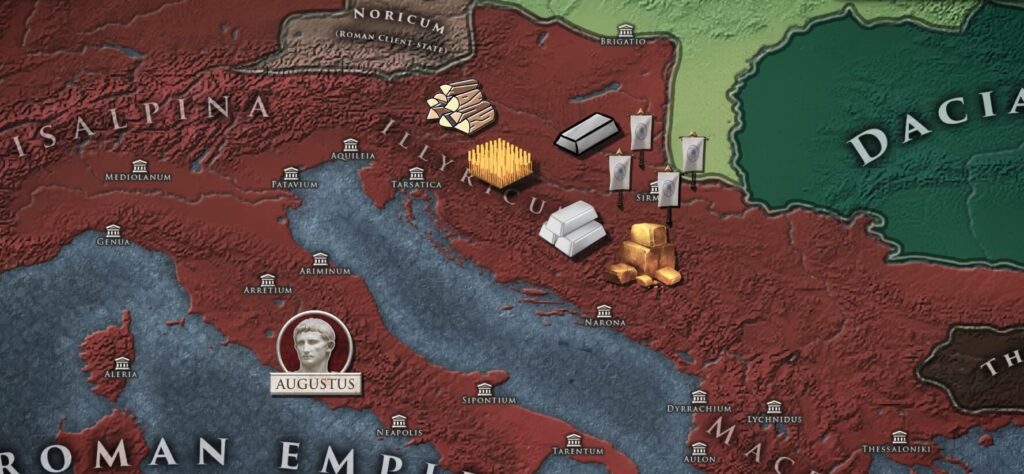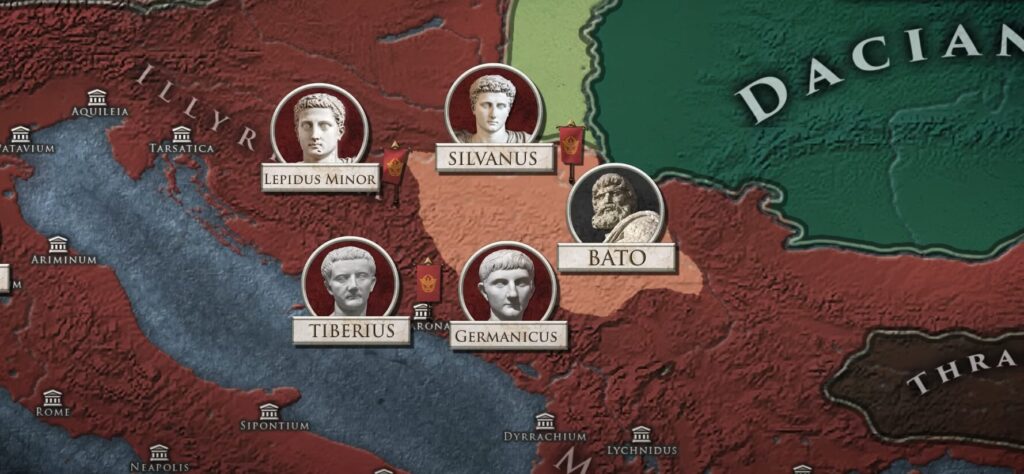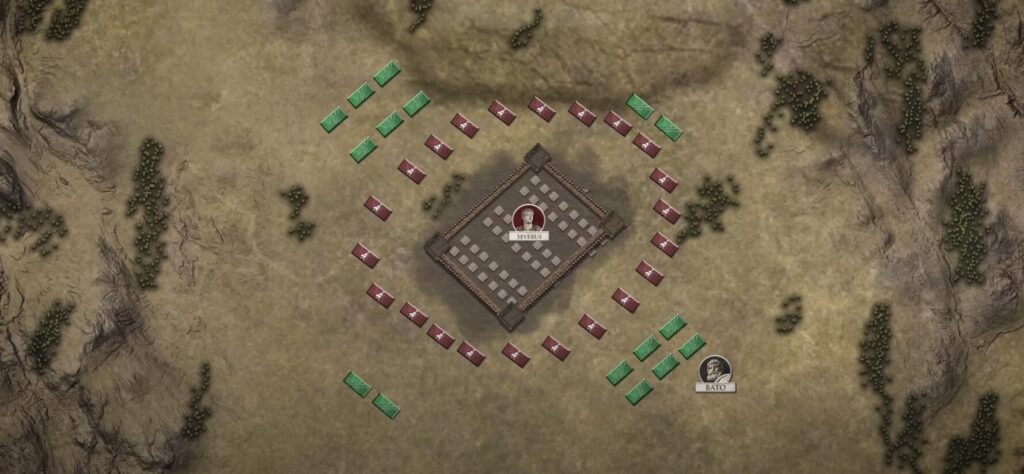The Roman Empire faced many challenges as it expanded across the Mediterranean, often clashing with strong and independent peoples. Among these were the Illyrians, a group whose homeland was rich in resources and strategically located across the Adriatic Sea. This region became a major focus for Roman interests, especially as its inhabitants resisted foreign rule and exploitation by the empire.
Tensions in Illyria rose as Rome demanded more resources and conscripted local fighters into distant wars. Eventually, these pressures led to a major uprising known as the Great Illyrian Revolt. The conflict would test Rome’s military strength and highlight the determination of the Illyrian tribes.
Key Takeaways
- The Illyrians fiercely resisted Roman control and exploitation.
- The Great Illyrian Revolt became one of Rome’s most serious internal threats.
- Both sides used complex strategies, shaping the legacy of the region.
Who Were the Illyrians?
The Land and Natural Wealth of Illyria
Illyria was a rugged region found in the western Balkans, just across the Adriatic Sea from Italy. The area was well known for its many mountains but also included fertile valleys and plains. Illyria was rich in natural resources such as silver, gold, iron, timber, and good farmland. These resources attracted the attention of outside powers, especially the Romans, who made use of Illyria’s mines and crops.
Main Illyrian Groups: Coastal and Inland Peoples
People living in Illyria belonged to many different tribes. The two largest groups the Romans were most concerned with were:
| Group | Location |
|---|---|
| Dalmatae | Lived along the coast and into the southern mountain regions |
| Pannonii | Found in the north, in areas now called Noricum and Pannonia |
Other smaller tribes also lived in the area. Some of these included the Venetic peoples and various tribes from Moesia and Thrace, who mixed with the Illyrians.
Peoples Next Door and Cultural Exchange
Illyria shared borders with many groups. In the past, they had often fought with neighbors like the Greeks and Macedonians. Philip II of Macedon had even conquered parts of the region. As time went on, Illyrians came into contact with Romans and other nearby peoples like the Thracians and Dacians.
Cultural exchanges happened through trade, war, and alliances. The Illyrians were drawn into Roman wars and sometimes joined with other local tribes against outside threats. This constant contact with neighbors shaped life in Illyria and influenced the course of their history.
Roman Conquest and Control of Illyria

Early Roman Actions and Domination
The Romans encountered the Illyrians across the Adriatic in the rugged western Balkans. These lands were divided between important groups, including the Dalmatae near the coast and in the mountains, and the Pannonii further inland. Rome often viewed the region as dangerous, but attractive for its natural wealth such as silver, gold, iron, timber, and good farmland.
To tighten their grip, Roman leaders called for the conscription of local men to support military campaigns, including foreign wars. This led to growing frustration among Illyrians who already faced increased demands for taxes and supplies. Their resentment erupted in a large rebellion led by a local war chief named Bato, who united several tribes and drew more support by highlighting their numbers and shared anger at Roman rule.
Roman military responses were rapid and included alliances with Thracian leaders and the redeployment of experienced commanders. The fighting saw several large battles and shifting control, with both sides suffering losses. The Romans eventually used reinforcements, tighter organization, and allied support to confront the rebels.
Timeline of Major Events
| Year | Event |
|---|---|
| 14-10 BCE | Previous local revolts in Illyria |
| 6 CE | Mass conscription leads to rebellion at Sirmium |
| 6-7 CE | Major battles and sieges throughout the region |
Roman Resource Extraction and Administration
Illyria’s mountains and fertile plains were a major focus for resource extraction. The Romans controlled and worked silver and gold mines, collected iron, logged timber, and managed agriculture. The region’s output was required to support the Roman economy and military, especially as new funds were needed for the soldiers’ treasury.
Roman leaders set up local governments run by experienced officials and split command between military and civil rulers. Taxes increased as Rome demanded more grain and goods to cover shortages in Italy and pay for its armies. The local population often bore these new burdens.
Key Impacts on Illyria:
- Land use: Much farmland and forest was taken over for Roman needs.
- Mining: Important mines provided resources for the Roman state.
- Heavy taxation: Local communities faced higher taxes to pay for Rome’s military expenses.
Provincial Administration Table
| Administrative Action | Effect on Illyrians |
|---|---|
| Tax increases | Caused hardship and unrest |
| Forced conscription | Led to rebellions |
| New officials sent by Rome | Reduced local independence |
How the Illyrian Uprising Began and Why It Happened

Events That Started the Revolt Based on Roman Accounts
Most Roman historians wrote that the Illyrian revolt began suddenly. The main sources, Velleius Paterculus and Cassius Dio, explained that the Roman governor, Marcus Valerius Messalla Messallinus, ordered many Dalmatian and Pannonian men to gather near Sirmium for military service. At this meeting, Bato of the Daesidiates tribe spoke out, encouraging rebellion by pointing to the crowd’s large size as a sign of potential power against Rome.
He convinced many to join the cause, and this sparked the uprising. The Romans did not expect this. Messallinus had considered the region safe before he left for the Danube with most of the legionaries. Roman records did not give a clear reason for the revolt, though they noticed that unrest was high and the amount of forced recruitment was unusual.
Strains from Taxes and Economic Burdens
Illyria was valuable for its mines, timber, iron, and farmland. The Romans made heavy demands on these resources, requiring grain and other goods, especially when Italy faced famine or disasters. Taxes were raised even more in this period to pay for the new military treasury.
This meant that regular people in Illyria faced more hardship. Many resources left their lands for Rome, and families struggled under higher taxes and greater pressure to give up what they had. Modern historians believe that anger over this economic exploitation was one of the main reasons people in Illyria lost patience with Roman rule.
| Economic Factor | Impact on Illyrians |
|---|---|
| Increased taxes | Greater financial strain |
| Forced delivery of grain | Less food for local people |
| Resource extraction | Loss of wealth from mines and forests |
Impact of Forced Service and Imperial Expectations
A key reason for the revolt was the high number of Illyrians forced to join the Roman army. Rome needed troops for its wars in Germania and ordered many conscripts from these regions. Large groups of recruits were gathered at once, making it easier for them to talk and plan together.
Illyrians were sent to fight far from home, which was unpopular and increased resentment. They saw that many of their able men were forced to serve in foreign wars, often against their will. The gathering at Sirmium became the perfect moment for leaders like Bato to encourage an organized rebellion, turning anger over conscription and imperial demands into open resistance.
Main effects of Roman military conscription:
- Illyrians had to fight away from home
- The process brought together large groups of young men
- Discontent over conscription became widespread
This combination of immediate events, unfair taxes, and forced military service pushed the Illyrians toward revolt.
Leading People in the Uprising
Bato, Leader of the Daesidiates
Bato led the Daesidiates, one of the main Illyrian tribes involved in the revolt. He became the face of the rebellion when he encouraged the gathered conscripts and locals to rise up against Roman authority. Bato argued their large numbers showed they could defeat the Romans.
He was hurt by a ballista stone during the attack on Salona but continued to rally his people. Under his leadership, the rebels attacked various cities and even moved toward Italy. Bato’s influence extended to organizing the defense in the mountains when Roman forces tried to suppress the revolt.
Key Traits:
- Strong motivator
- Strategic, using terrain for defense
- Persistent despite injuries
Bato, Chief of the Breuci
Bato of the Breuci became important when his tribe joined the rebellion. The Breuci swelled the rebel army and fought against Roman commanders. After suffering a surprise attack led by Messallinus, Bato and his people linked up with Bato of the Daesidiates.
While his tribe was not as heavily featured as the Daesidiates, their alliance helped keep the rebellion going longer. Bato of the Breuci often supported the main efforts led by the Daesidiates but also led his tribe in battles and retreats as needed.
Highlights:
- Joined forces with other rebel tribes
- Led his people in battle and retreat
- Helped extend the scope of the revolt
Roman Military Leaders: Tiberius, Messallinus, and Germanicus
The Romans sent three main commanders to deal with the Illyrian uprising:
| Commander | Role | Notable Actions |
|---|---|---|
| Tiberius | Main Roman general | Chose Segestica as base, managed relief and battles, commanded a large army |
| Messallinus | Proconsul of Illyricum | Fought Bato of the Breuci and won by ambush, returned quickly to the region for suppression efforts |
| Germanicus | New army leader, Augustus’ relative | Led fresh forces into Illyricum to support Tiberius and relieve pressure on Roman lines |
These leaders worked together but also faced separate challenges. Tiberius and Messallinus organized defenses and fought in key battles, while Germanicus arrived later with new troops to support ongoing campaigns. Their joint efforts helped bring about the gradual defeat of the Illyrian rebels.
The Path of the Great Illyrian Rebellion
Early Outbreaks and Gathering of Forces
The turmoil began when Roman authorities ordered the Dalmatians and Pannonians to assemble for conscription near Sirmium. As these groups gathered, Bato from the Daesidiates tribe encouraged a revolt against Roman control, rallying support from both his own and the Breuci tribe. The number of rebels rapidly grew, sometimes rumored to have reached 200,000 fighters, though this is likely an exaggeration. Roman resources and tough conscription standards fed the anger of the Illyrians, who now stood together against Roman oversight.
Key Points:
- Dalmatians and Pannonians unite
- Bato becomes a leading figure
- Discontent grows due to Roman demands
Attack on Salona and Roman Military Response
Bato led the rebels to target the key city of Salona. During this attack, a Roman ballista injured Bato and caused the besieging forces to scatter. Although their direct assault failed, the rebels caused destruction as they moved towards the coast and Apollonia. Rome responded swiftly, bringing in Thracian allies and nearby governors such as Aulus Caecina Severus. The Romans prepared to counter the Illyrians with legions and emergency powers, mobilizing retired soldiers and economic support from Rome’s elite.
| Event | Details |
|---|---|
| Siege of Salona | Bato wounded, siege ends |
| Coastal Raids | Rebels spread destruction |
| Roman Response | Legions, allies, veterans |
Pushes Toward Italy and Increasing Danger
Rebel forces tried to invade Italy by crossing the Julian Alps. This move set off alarms in Rome, forcing Augustus to organize rapid defenses and draw on every resource. The attacks left Roman territory unstable, with rebels harassing Roman supply lines and causing chaos as far as Macedonia and Thrace. Winter weather made it harder for the Romans to fight back, giving the Illyrians time to regroup and raid with little resistance.
Rebel Actions:
- Attempted invasion of Italy
- Disruption of key supply routes
- Raids into nearby provinces
Major Clashes Near the Drava River and in the Julian Alps
The Romans engaged the rebels at the River Drava, but the marshy terrain favored the defenders. After initial Roman setbacks, the arrival of Thracian allies helped turn the tide. Even so, both sides suffered heavy losses, and the fighting pushed deeper into Illyria’s mountains.
Later, Roman forces under Tiberius and Messalinus, with reinforcements from the historian Velleius Paterculus, broke a rebel siege at Segestica, defeating a large Illyrian army and lifting the siege. Meanwhile, Germanicus Caesar was called in to lead new Roman units, including freedmen and volunteers, showing the seriousness of the conflict.
Notable Battles:
- River Drava: Marshy ground, heavy losses
- Segestica: Roman relief of besieged forces
- Julian Alps: Rebel attempts to reach Italy
Both sides fought hard with large armies. The Illyrians dug in, using the land to their advantage, while Rome answered with overwhelming numbers and resources.
Roman Strategies and Counteractions

Involvement of Thracian Partners
Roman forces were not alone in their efforts. They called upon local allies, especially from Thrace. King Roimetalkes led his Thracian warriors to assist the Romans against the rebellious Illyrians on the eastern front. With Thracian support, Roman troops managed to defeat rebel armies and force them back into the mountains, though they suffered many losses along the way. The partnership with Thrace proved important for holding ground and pushing back against the widespread revolt.
Key Supporters:
| Ally | Contribution |
|---|---|
| Thracian forces | Reinforced Romans |
| King Roimetalkes | Led Thracian army |
Battle Tactics and Supply Problems
The Romans faced tough conditions, including unfamiliar and marshy terrain. These landscapes often helped the defenders. Early on, Roman troops were pushed back but managed to regroup after their allies arrived. The Illyrians used the rough land to their benefit, attacking supply lines and ambushing Roman units.
Logistics were a big challenge. Large armies needed steady resources, especially during the winter. Illyrian fighters raided Roman camps and supply routes, making it harder to get food and equipment to troops in the field. Roman commanders had to plan careful marches, place bases in safer spots like Segestica, and use ambushes where possible.
- Difficult landscape slowed army movements
- Illyrian raids threatened Roman supplies
- Roman forces sometimes outnumbered
Choices Made by Augustus and Tiberius
Leadership had a major impact on the course of the conflict. Augustus reacted to the growing threat by calling for emergency actions. He pulled together troops from multiple sources, including veterans, citizens, and even freed slaves. He also relied on leading family members, first hoping for Agrippa, but later turning to Germanicus Caesar for command support.
Tiberius, in charge of the campaign, was slow to shift his focus from other regions, but after forming a truce on the frontier, he redirected his efforts to Illyricum. Together with commanders like Messallinus, he chose strategic bases, faced sieges, and sent relief forces. Tiberius brought in a massive army and reorganized Roman efforts to respond to the changing situation.
Leadership Actions:
- Augustus increased army recruitment
- Tiberius planned new campaigns after securing the border
- Special units of volunteer cohorts were created and sent to assist
Influence and Lasting Results of the Uprising
Changes in Illyria and the Western Balkans
- Roman demands for soldiers and resources pushed the people in Illyria to rebel.
- The revolt brought heavy damage to towns along the coast and in the countryside.
- Many local groups, such as the Dalmatae and Pannonii, lost people and property as fighting spread across the region.
- After the uprising, Rome tightened control and kept a closer watch on Illyrian communities.
| Group Involved | Outcome |
|---|---|
| Dalmatae | Suffered losses, stricter Roman rule |
| Pannonian tribes | Forced into more Roman oversight |
| Other local peoples | Greater presence of Roman officials |
Changes to Roman Army Practices
- Roman leaders realized their provinces were at risk if troops were sent far away.
- They raised new armies, including freedmen and volunteers, to face emergencies.
- Veterans and wealthy citizens stepped in to support military needs.
- Roman policy shifted to keep more troops stationed in risky areas like Illyria.
Key Responses:
- Emergency levies
- Use of local and allied forces
- Better planning for local threats instead of only foreign invasions
Later Effects on Rome and Illyrian Connections
- Tensions stayed high between Rome and Illyrian peoples even after the fighting ended.
- Roman officials worked harder to collect taxes and resources, sometimes leading to more unrest.
- New troops and outposts remained in place for years after the uprising.
- Roman leaders paid more attention to the region during future military campaigns and politics.
